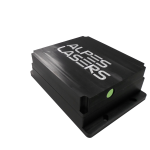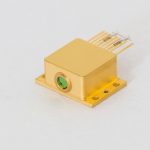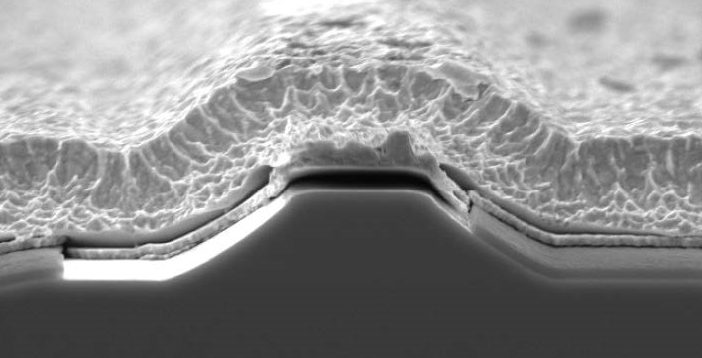
QCLs from Alpes Lasers are generally available from inventory in the wavelength region from 3.2 to 16+ microns. Ongoing developments are expanding the waveband ranges to both higher and lower wavelengths.
There are a range of options for packaging your QCL.
Devices are available as:
Individual single-mode lasers. Distributed feedback, or DFB, devices are available in continuous-wave (CW) or pulsed operation.
Standard Fabry-Pérot (FP). FP QCLs do not have an integrated optical grating to select a single spectral mode
High Power multimode sources. These Quantum Cascade Lasers have a minimum average power of 1W and more than 9W of peak power. Available in a collimated HHL package with a dedicated driver, these lasers can be used for free-space optical communications, energy deposition, illumination and IR countermeasures.
Broad Gain lasers. These lasers are Fabry-Pérot lasers designed for maximum width of the gain profile. They can be used as broad spectrum illuminators for spectroscopy or imaging. Combined with an anti-reflection coating, they are suitable for use in an external cavity to obtain a tunable laser with wide tuning range. Their wide and flat gain spectrum can also be suitable to develop frequency combs.
Extended tuning sources available in HHL packages Alpes Lasers offers two types of extended tuning devices, both of which allow rapid tuning at fixed temperature in a wider range than standard DFB lasers. The QC-ET allows fully continuous tuning over 0.4% of the central wavelength, while the QC-XT allows piece-wise continuous tuning over 2% of the central wavelength.
Frequency Comb Quantum Cascade Lasers. Frequency Comb QCL are devices emitting light on a wide spectrum consisting of equidistant peaks in frequency space. The distance between these peaks being fixed, typically given by the pulse repetition rate of a train of ultrashort pulses, they can be used as rulers in the frequency domain for Frequency Comb Spectroscopy.
External Cavity Kit for larger tuning range. Alpes Lasers’ line of External Cavity Laser Kit (ECLK) is designed for single-mode operation with wide spectral tunability. The ECLK consists of a quantum cascade laser (QCL) gain chip, a grating-tuned extended optical cavity in Littrow configuration, laser drive electronics, an Alpes Lasers TC-3 temperature controller, and a graphical user interface software.
SWIR Laser Diodes. Short Wave Infrared Laser Diodes are continuous wave, multiple longitudinal mode Fabry-Perot devices emitting light over a bandwidth of ~20 nm with output power up to 50 mW. They are offered either as chip-on-carrier or encapsulated in a low power TO-66 package with collimated or divergent free-space beam output.
Alpes SWIR Laser Diodes can be tailored in the range from 1.45-2.2 microns with each design having a bandwidth of ~20 nm. Available wavelengths include the absorption bands of N2O, H2O, CH4 and HCl among others.
Starter kit: we offer a “starter kit” of hardware to stabilize the QCL device temperature at any temp from -30C to +30C and to energize (drive) the device. Details of the “starter kit” are contained in our catalog.
Last, but not least, QCLs are made on wafers. Each wafer can contain many devices of similar performance. Alpes has now build QCLs at a number of wavelengths in the 5 to 10+ micron region. We encourage you to ask what wavelengths are available in semi-fabricated form. If one meets your needs it may be less expensive and faster delivery than an entirely new one.
See our catalog at the link at the bottom of the page.
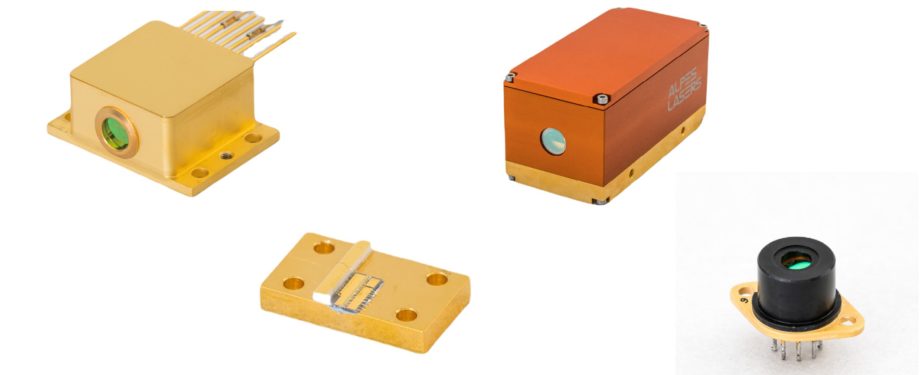
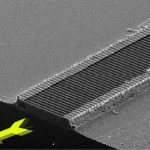 operation. The first is to ‘write’ a grating on the device itself so that the device emits at a specific wavelength set by the grating frequency. Tuning is then accomplished over a very narrow frequency/wavelength region by varying the device temperature which in turn varies the index of refraction of the device material and thus varies the optical path length with respect to the grating and thus varies the emitted wavelength. This method typically allows tuning over 4 to 10 cm-1. These gratings are referred to as “distributed feedback” mechanisms or DFBs, and a QCL that has such a grating is a DFB-QCL.
operation. The first is to ‘write’ a grating on the device itself so that the device emits at a specific wavelength set by the grating frequency. Tuning is then accomplished over a very narrow frequency/wavelength region by varying the device temperature which in turn varies the index of refraction of the device material and thus varies the optical path length with respect to the grating and thus varies the emitted wavelength. This method typically allows tuning over 4 to 10 cm-1. These gratings are referred to as “distributed feedback” mechanisms or DFBs, and a QCL that has such a grating is a DFB-QCL.